Podcast: Play in new window | Download (Duration: 20:12 — 21.4MB)
Subscribe: Apple Podcasts | Spotify | Amazon Music | Android | Pandora | iHeartRadio | JioSaavn | Podcast Index | Email | TuneIn | RSS | More
By Davy Crockett
![]()
![]()
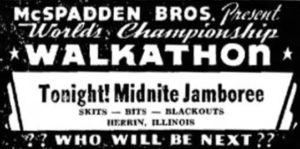
The original walkathons were not the relatively tame fundraising walks of the 1970s for causes. Instead these walkathons were brutal endurance events that had their heyday in the mid-1930s. These walkathons were not ultrarunning events. They were rather twisted walking events, if it could even be called walking. They were mostly a crazy test of enduring sleep deprivation. But still, it is important to understand the history of these competitions, because they had a negative impact on true extreme endurance sports such as ultrarunning in the minds of Americans for future decades.
The Walkathon was believed to be invented in America, in 1913, at Terra Haute, Indiana. Achieving miles was not the objective. The goal for the walkathon was to survive for weeks and to be the last one standing.
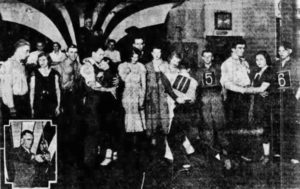

Rules
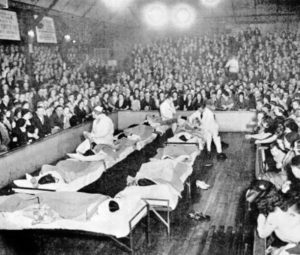

Rules varied and could be changed mid-stream. In order to have an event last for weeks, generally after the first three hours, rests were given each hour. For example at a 1932 walkathon in Oregon, contestants would walk for 45 minutes, and then rest/sleep 11 minutes off stage. They would come back out at the sound of a gong or airhorn and then sit in front of the audience for four minutes getting ready for the next hour. Sometimes during the evenings, cots were brought out onto the floor in front of the crowds and walkers were forced to stay on the floor to rest and sleep.
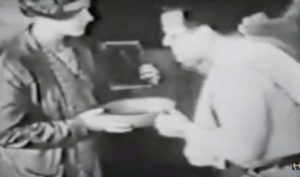

Couples walked together and could hold each other up when things got rough. One verteran contestant would hold his partner up for four hours while she slept on her feet. When rest periods came, they gained the skill of being able to fall asleep within ten seconds. If one member of the couple dropped (literally) out, the other person could continue for a time “solo” with the disadvantage of not being aided by another person. When another person of the opposite sex became available because their team member was also out, the two could team up as a new couple. Dancing was sometimes allowed among the contestants during hours stipulated by the state law and city ordinances. (Des Moines Register, Sep 1, 1929).
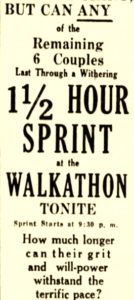

The walkathon staff included doctors, nurses, judges and a master of ceremonies. The physician examined the participants daily and disqualified anyone who was not in good health. The floor judges disqualified anyone who stopped walking, left the floor without permission, fell to the floor, or accepted any food or tobacco from any one unauthorized, and not at designated times.
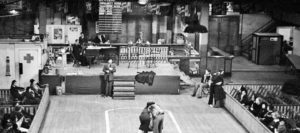

As the days would go on with no end in sight, promoters wanting to wrap things up and move to the next city, would change the rules, making walking periods longer or resting periods shorter. Promoters would use the intense “derby” periods to wear down the contestants. A walkathon in Austin, Texas forced the walkers to “sprint” for two hours until a doctor put a stop to it. They next tried to “sleep out” the group. Contestants were tied together five feet apart and not allowed to hold each other up. The lights over the floor were turned out and the band played lullabies. The walkers could only pull on the rope to try to keep their partner from falling asleep. These were called Zombie Treadmills. (The Austin American, Dec 18, 1933).
Spectators
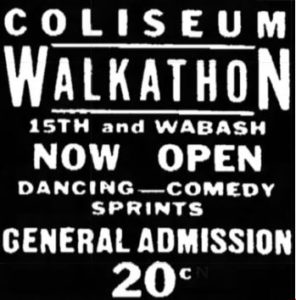

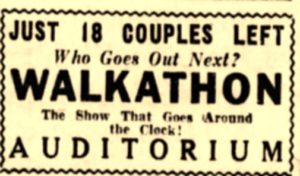

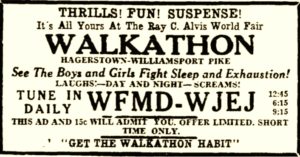

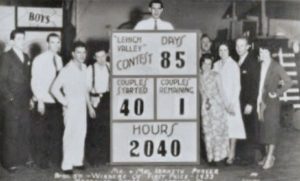

Entertainment
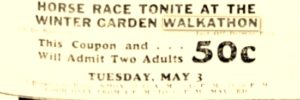

It was challenging to provide entertainment around the clock. The time was filled by comics, clowns and stooges. Floor judges were the villains and often called “The Meanest Man in Town.” (Frank Calabria, Dance of the Sleepwalkers).
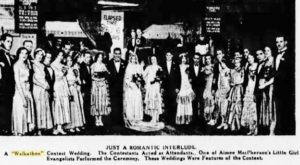

Contestants
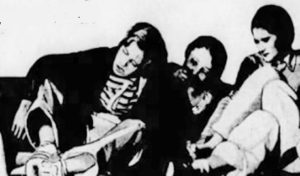

Walkathons averaged 2 1/2 months. Contestants often signed an agreement that no prize money was issued if the contest didn’t go more than 1,000 hours. In a contest in Missouri, two couple split the prize money after walking 1,447 hours. For each that resulted in earning about 15 cents per hour.
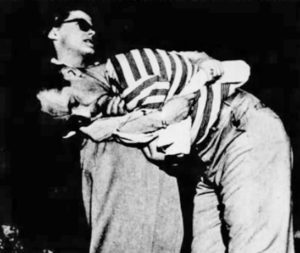

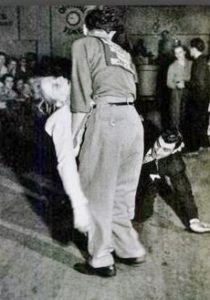

Contestants usually would gain weight during the walkathon. “No one will go hungry and some are expected to gain weight for they are fed seven meals a day, three being full-course meals, prepared by the chef on the grounds and under the direction of a dietician.” (The Dailey Mail, Nov 10, 1933)
Julia Baruffi
In 1933, young Julia Baruffi of New Jersey entered a walkathon in the Convention Hall in Atlantic City against the wishes of her parents. She had her eye on the $1,000 prize money and promised her parents that if she became ill she would return home immediately. He event required participants to walk 90 minutes and then rest 15 minutes. She ate while standing and walked with used several partners because her partners kept dropping out. She even had to walk “solo” for an astonishing 16 days waiting for another partner to become available.
During the event Julia sang songs in Italian for the audience that sometimes reached 10,000 spectators. She also sang on two radio broadcasts. Adoring spectators threw her gifts and flowers. She sent the flowers to a nearby church and the priest came to thank her. The big attraction of her walkathon was the entertainment from a young redheaded Red Skelton who would carry her five-year-old sister around on his shoulders. During the walkathon Miss American was chosen there. Two enormous weddings were conducted. In the end, Julia won, lasting 96 days. (The Daily Journal, Jul 1, 1954)
Poking Fun at Walkathons
Many of the general public thought Walkathons were freak shows and were amazed by the walkathon craze that was going on.
In 1937 the U.S. director of the bureau of fisheries announced that he would stage a fish walkathon, using a breed of fish that were known to walk through the grass from one pond or lake to another. He said, “There’s just one drawback, and we can probably overcome that, young walking fish have a tendency to faint when excited.” (The Times Herald, 3 Mar 1937).
Poking fun, once again, this appeared in a 1938 Phoenix Arizona newspaper: “Those Golf Walkathons. Golf is face to face with a new menace, the marathon golfer. They non-stop hook-and=slice craze is definitely spreading. It is nothing to encounter on any golf course a golf maniac off to play 200 or 300 holes in a test to determine how many hours he can spend in the rough without going mad.” (Arizona Republic, Sep 4, 1938).
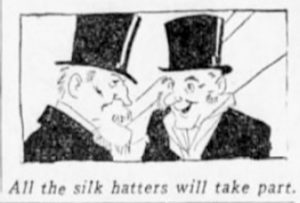

Opposition
The walkathons had their controversy and were opposed by many groups. Church ministers were opposed to them because they were held on Sundays and were viewed as being immoral. One minister said the walkathon “commercializes our youth, is morally and socially degrading, injures the health and is an unwholesome reflection upon the reputation and ideals of the community.” (The Daily Journal, Oct 24, 1933). Movie theaters opposed them because they drew away most of their customers who were more interested in watch reality events. A national columnist called the walkathon “the lowest form of athletics or sporting endeavor.” Another critic wrote, “For more than three months East Detroit has been treated to the spectacle of human beings walking around a dance floor, day and night, hour after hour, like animals in a treadmill or slaves in a galley, living without sleep save brief rest periods.” (Detroit Free Press, Jan 15, 1933).
Cities used various tactics to try to disrupt these events. Police would watch these events closely and would at times arrest people for vagrancy. They would check out contestants’ backgrounds and arrest those who had outstanding warrants, dragging them off the floor. The newspaper at Bend Oregon editorialized that “The ‘walkathon’ is something which should be outlawed, along with other barbarities.” (The Bend Bulletin, May 19 1931).
Corruption raised its ugly head in this highly profitable business. At times winners did not receive their prizes. Professional walkers essentially became employees for the promoters and would introduce staged drama into the events that were becoming more show than a contest. Wagering introduced corruption. At one walkathon, an unusual number of walkers were dropping out at early stages of the contest. It was discovered that “gangsters” had formed a betting pool and had bribed the cook who put sleeping powders in the food of some walkers. They would become so sleepy that they would slide to the floor. Local racketeers would demand cuts in the receipts. Sometimes the cuts were so large that the show had to close.
In 1938 a former professional walkathoner who participated in 35 events did a “tell-all” interview for a newspaper in Maryland. At his first walkathon, he discovered that he was mostly expected to be an actor and that all the judges, nurses, and trainers were actors “for the sole benefit of the audience.” It was all about box office receipts. This professional was in the business for eight years and had seen fraud in most of of his events. Walkers were ordered to “take a fall” similar to the fixing in boxing to “take a dive.” When spectators were not in the buildings the rules went away for walkers that were targeted to go the distance. If a professional could sing and dance well, they were a favorite of the crowd and needed to stay in the game. When certain professionals wanted to leave, they were forced to stay and in one case a boy was beaten up when he tried to escape and the audience was told he had an accident during the rest period. Derbies were rehearsed in the morning when spectators were away, to put in acts to increase the drama. (The Daily Times, Feb 5-6, 1938). Even though most of these events were likely fixed and staged, the contestants still required amazing physical endurance.
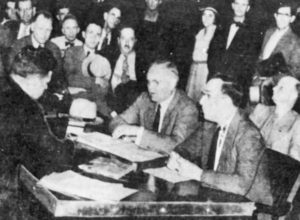

All sorts of legal maneuvers were used to halt these traveling endurance events. At Salem Oregon it was determined that walkathons violated labor laws because women and minors were involved. Also employers needed to provide employees nine hours of rest between days of work. (Medford Mail Tribune, May 29, 1931).
During an event when contestants were ordered to testify in court, sometimes they continued to walk outside the courtroom and hoped to testify during their 15-minute rest time. An attorney asked the judge, “Your honor, have you given any authority to turn the court room into a walkathon? There are several of the walkathoners walking around out there!” (The Tamp Tribune, Jan 18, 1935).
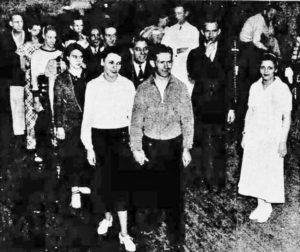

Critical articles appeared in the newspapers calling walkathons rackets. Cities started to pass ordinances against them. Arrests were frequent. Los Angles County banned “walkathons and other endurance exhibitions, similar and in kind, which do not promote clean, healthful athletic endeavor.” (The Los Angeles Times, Sep 27, 1932).
Other tactics were used. In Kansas City customers were driven from the venue by a group of city officials who claimed the decorations in the hall and wooden bleachers were fire hazards. A rumor was also started the walkathon was barring Italians from witnessing the contest. (The Sedalia Democrat, Feb 24, 1932). Another city’s prosecutor raged, “We will close the Walkathon if we have to use force of arm!”
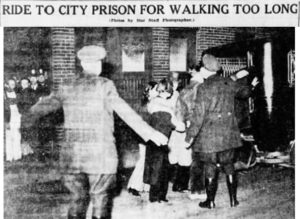

At a 1933 walkathon held in Indianapolis, at about the 1,800-hour mark, 25 policemen arrived to shut it down because of a new ordinance that was passed only the day before restricting endurance events to 12 hours on any given day. The promoter refused to stop the event. The Chief of police “gave the signal and the police who had been assembled near the front door started down the aisles. Immediately the piano blared the tune ‘Big Bad Wolf’ while the master of ceremonies sang. As police neared the dressing rooms where the contestants were taking a fifteen-minute rest, the tune was changed to ‘The Last Roundup.’ Spectators applauded and yelled. As the crowd quieted down, the masters of ceremony asked, “I wonder who is guarding the banks and filling stations?” 28 contestants were hauled off to jail. They were released a few hours later on $200 bond and the walkathon continued on. But after the promoter met with a judge, the event was shut down. Defiant, the attorney for the walkathon said they wouldn’t be stopped, that in the future to meet the city law, they would hold a “series” of walkathons that lasted eleven and a half hours each day. (The Indianapolis Star, Dec 3, 1933).
A very successful walkathon was held in San Francisco in 1931 with a profit of $100,000 (1.6 million in 2018 dollars). San Francisco was the most successful city to chase away this scourge from their city. Newspapers discovered that the more they criticized these events, the more the public attended them, so the newspapers boycotted coverage and hardly anyone paid attention to them and returned to the movie theaters. The walkathon moved to other cities. Conservative Salt Lake City, Utah was “thrilled” by the event.
Promoters often countered the opposition by donating thousands of dollars to local city causes. Some cities ignored the uproar. Minneapolis netted $12,000 for renting its auditorium in 1932. Other walkathons started in 1933 which gave 75% of the profits to local charities.
All these bans contributed against any resurgence of ultrarunning multi-day fixed time races. Kansas City passed an ordinance on walkathons or “any other type of endurance or speed contests.” They imposed limits for all contest to twelve hours in a 24-hour period. (Journal and Courier, Aug 9, 1932).
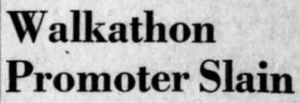

It was estimated that 20,000 people made their living in 1935 in walkathon shows. But the walkathon fad dwindled greatly by 1940 as they became more show business than a contest. Loyal fans detected that the events evolved into farces. They no longer believed in the endurance part since the same contestants won in every show. During World War II, professional walkathoners moved on to new jobs.
Brief Resurrection of Walkathons
After the war, there were attempts to revive walkathons and a few were held. But clearly it was an uphill battle against continued fierce opposition. In 1946 they were described as “an obscene and degrading spectacle” by the Arizona Industrial Commission. One of the great downfalls of the events were that they degraded into so many professional contestants who were viewed as employees, subject to employment laws. Many of the promoters were corrupt, didn’t pay employees as they should, and the walkathons became fake, duping people out of money.
In Phoenix, while two walkathons were being held In 1946, A front page article appeared in the Arizona Republic with the headline, “Walkathons Called Frauds; One Closes” It was discovered that none of the contestants were walking around the clock. Audiences left by 2 a.m. and spectators weren’t allowed back in until about 11:00 a.m. One outside witness once found all the “performers” asleep as late as 11 a.m. He asserted that “they are working 8 or 10 hours per day and getting plenty of sleep.” (Arizona Republic, Dec 19, 1946). Across the country newspapers condemned “the resurrection of the worst of all modern public spectacles.”
Walkathons End
By 1953 walkathons were pretty much gone. Half of the states were enforcing statutes against endurance contests. In other states, many cities barred walkathons with nuisance ordinances. Such a universal dislike of these fraudulent events certainly affected the public’s view toward any extreme endurance sport. It generated an atmosphere making it impossible to reestablish ultrarunning events that had mostly disappeared altogether before the war. It wasn’t until 1963 that attitudes shifted when President John F. Kennedy unintentionally helped the public see that 50-milers were cool and could be participated in by normal people.
The modern-day Walkathon
By 1955, a new use for the name “walkathon” emerged. It was used to refer to any long distance hike, walking back and forth in a picket line, going door to door for causes, or a baseball game with many walks issued. A three-day stage race near Corpus Christ Texas took over the term for its a 110-mile Padre Island Walkathon. This was likely the earliest true ultrarunning event in America since the war. Runners completed about 35-mile segments each day using aid stations every five miles, They hiked on beaches and trails. In 1954 the winner had a total hiking/running time of 22:45 for the total 110 miles.
In 1957 a 16 1/4 mile “Sonoma-Petaluma Walkathon” started in Californa and continued on for more more than two decades. It became the top walking race in California. While this event wasn’t a fundraising event, it emphasized walking and probably should be given credit as the first modern day walk-a-thon.
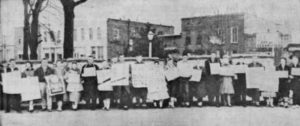

In 1958 the first “March of Dimes Walkathons” were first held. Tennessee held the largest when twenty Gibson County high school pupils walked from the court house in Trenton to their home towns. (Jackson Sun, Jan 26, 1958). In Iowa, three hikers raised $3,974 doing a walkathon from Ames to Des Moines. In Arkansas two county officials went about eight miles, raising about $4,000. In Reno, high school student clubs walked one foot for every dime raised for the March of Dimes. All of these were called walkathons.
1968 was the first major walkathon (walk-a-thon), and was sponsored by the American Freedom from Hunger Foundation. It received great attention after it was promoted by Jonny Carson and Ed McMahon. The walk-a-thon drew over 3,000 walkers on a 33-mile route through the streets for Minneapolis. The concept took hold and many groups started using it for fundraising. Early ultrarunners were known to have run in walk-a-thons, trying to be the first finishers.
Despite the damage caused by the original walkathons, a firm rebirth of ultrarunning occurred during the 1960s and it was allowed to thrive again by the early 1970s. The big difference in ultramarthons for the new modern era, was that professionals were few, and the every-day runner could enter the sport.
